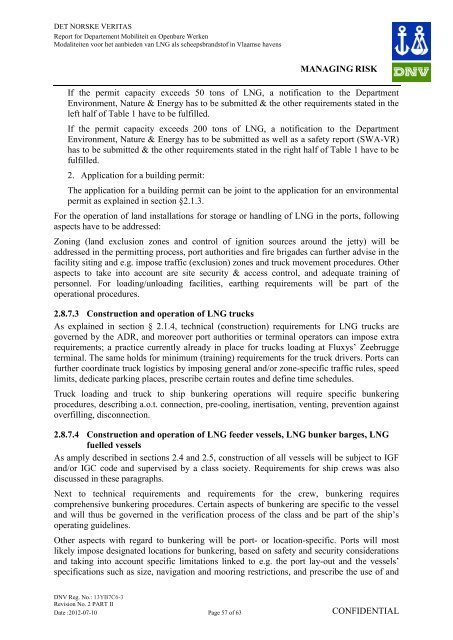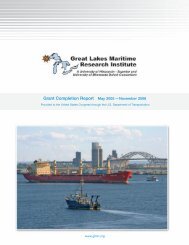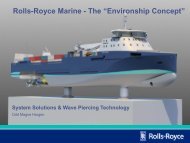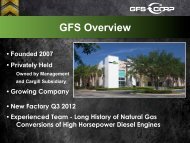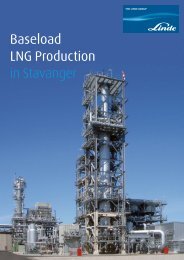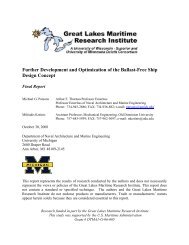Modalities for the provisioning of LNG as shipping fuel in Flemish Ports
Modalities for the provisioning of LNG as shipping fuel in Flemish Ports
Modalities for the provisioning of LNG as shipping fuel in Flemish Ports
Create successful ePaper yourself
Turn your PDF publications into a flip-book with our unique Google optimized e-Paper software.
DET NORSKE VERITAS<br />
Report <strong>for</strong> Departement Mobiliteit en Openbare Werken<br />
Modaliteiten voor het aanbieden van <strong>LNG</strong> als scheepsbrandst<strong>of</strong> <strong>in</strong> Vlaamse havens<br />
MANAGING RISK<br />
If <strong>the</strong> permit capacity exceeds 50 tons <strong>of</strong> <strong>LNG</strong>, a notification to <strong>the</strong> Department<br />
Environment, Nature & Energy h<strong>as</strong> to be submitted & <strong>the</strong> o<strong>the</strong>r requirements stated <strong>in</strong> <strong>the</strong><br />
left half <strong>of</strong> Table 1 have to be fulfilled.<br />
If <strong>the</strong> permit capacity exceeds 200 tons <strong>of</strong> <strong>LNG</strong>, a notification to <strong>the</strong> Department<br />
Environment, Nature & Energy h<strong>as</strong> to be submitted <strong>as</strong> well <strong>as</strong> a safety report (SWA-VR)<br />
h<strong>as</strong> to be submitted & <strong>the</strong> o<strong>the</strong>r requirements stated <strong>in</strong> <strong>the</strong> right half <strong>of</strong> Table 1 have to be<br />
fulfilled.<br />
2. Application <strong>for</strong> a build<strong>in</strong>g permit:<br />
The application <strong>for</strong> a build<strong>in</strong>g permit can be jo<strong>in</strong>t to <strong>the</strong> application <strong>for</strong> an environmental<br />
permit <strong>as</strong> expla<strong>in</strong>ed <strong>in</strong> section § 2.1.3.<br />
For <strong>the</strong> operation <strong>of</strong> land <strong>in</strong>stallations <strong>for</strong> storage or handl<strong>in</strong>g <strong>of</strong> <strong>LNG</strong> <strong>in</strong> <strong>the</strong> ports, follow<strong>in</strong>g<br />
<strong>as</strong>pects have to be addressed:<br />
Zon<strong>in</strong>g (land exclusion zones and control <strong>of</strong> ignition sources around <strong>the</strong> jetty) will be<br />
addressed <strong>in</strong> <strong>the</strong> permitt<strong>in</strong>g process, port authorities and fire brigades can fur<strong>the</strong>r advise <strong>in</strong> <strong>the</strong><br />
facility sit<strong>in</strong>g and e.g. impose traffic (exclusion) zones and truck movement procedures. O<strong>the</strong>r<br />
<strong>as</strong>pects to take <strong>in</strong>to account are site security & access control, and adequate tra<strong>in</strong><strong>in</strong>g <strong>of</strong><br />
personnel. For load<strong>in</strong>g/unload<strong>in</strong>g facilities, earth<strong>in</strong>g requirements will be part <strong>of</strong> <strong>the</strong><br />
operational procedures.<br />
2.8.7.3 Construction and operation <strong>of</strong> <strong>LNG</strong> trucks<br />
As expla<strong>in</strong>ed <strong>in</strong> section § 2.1.4, technical (construction) requirements <strong>for</strong> <strong>LNG</strong> trucks are<br />
governed by <strong>the</strong> ADR, and moreover port authorities or term<strong>in</strong>al operators can impose extra<br />
requirements; a practice currently already <strong>in</strong> place <strong>for</strong> trucks load<strong>in</strong>g at Fluxys’ Zeebrugge<br />
term<strong>in</strong>al. The same holds <strong>for</strong> m<strong>in</strong>imum (tra<strong>in</strong><strong>in</strong>g) requirements <strong>for</strong> <strong>the</strong> truck drivers. <strong>Ports</strong> can<br />
fur<strong>the</strong>r coord<strong>in</strong>ate truck logistics by impos<strong>in</strong>g general and/or zone-specific traffic rules, speed<br />
limits, dedicate park<strong>in</strong>g places, prescribe certa<strong>in</strong> routes and def<strong>in</strong>e time schedules.<br />
Truck load<strong>in</strong>g and truck to ship bunker<strong>in</strong>g operations will require specific bunker<strong>in</strong>g<br />
procedures, describ<strong>in</strong>g a.o.t. connection, pre-cool<strong>in</strong>g, <strong>in</strong>ertisation, vent<strong>in</strong>g, prevention aga<strong>in</strong>st<br />
overfill<strong>in</strong>g, disconnection.<br />
2.8.7.4 Construction and operation <strong>of</strong> <strong>LNG</strong> feeder vessels, <strong>LNG</strong> bunker barges, <strong>LNG</strong><br />
<strong>fuel</strong>led vessels<br />
As amply described <strong>in</strong> sections 2.4 and 2.5, construction <strong>of</strong> all vessels will be subject to IGF<br />
and/or IGC code and supervised by a cl<strong>as</strong>s society. Requirements <strong>for</strong> ship crews w<strong>as</strong> also<br />
discussed <strong>in</strong> <strong>the</strong>se paragraphs.<br />
Next to technical requirements and requirements <strong>for</strong> <strong>the</strong> crew, bunker<strong>in</strong>g requires<br />
comprehensive bunker<strong>in</strong>g procedures. Certa<strong>in</strong> <strong>as</strong>pects <strong>of</strong> bunker<strong>in</strong>g are specific to <strong>the</strong> vessel<br />
and will thus be governed <strong>in</strong> <strong>the</strong> verification process <strong>of</strong> <strong>the</strong> cl<strong>as</strong>s and be part <strong>of</strong> <strong>the</strong> ship’s<br />
operat<strong>in</strong>g guidel<strong>in</strong>es.<br />
O<strong>the</strong>r <strong>as</strong>pects with regard to bunker<strong>in</strong>g will be port- or location-specific. <strong>Ports</strong> will most<br />
likely impose designated locations <strong>for</strong> bunker<strong>in</strong>g, b<strong>as</strong>ed on safety and security considerations<br />
and tak<strong>in</strong>g <strong>in</strong>to account specific limitations l<strong>in</strong>ked to e.g. <strong>the</strong> port lay-out and <strong>the</strong> vessels’<br />
specifications such <strong>as</strong> size, navigation and moor<strong>in</strong>g restrictions, and prescribe <strong>the</strong> use <strong>of</strong> and<br />
DNV Reg. No.: 13YB7C6-3<br />
Revision No. 2 PART II<br />
Date :2012-07-10 Page 57 <strong>of</strong> 63 CONFIDENTIAL


